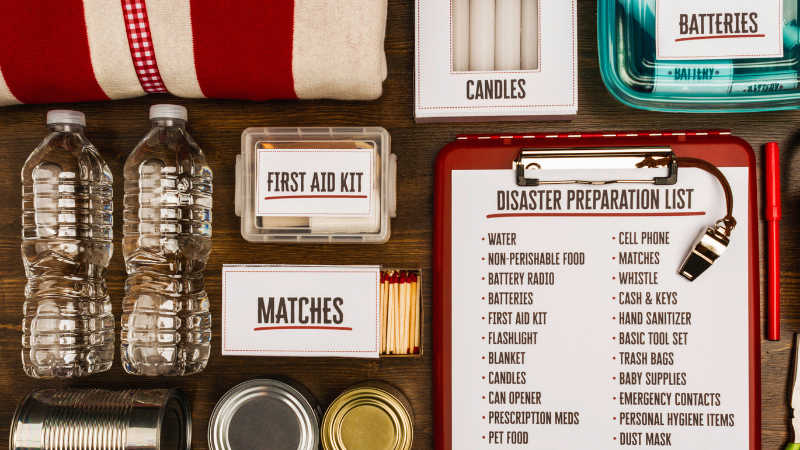AARP Hearing Center

September is National Preparedness Month, the annual campaign to remind everyone that preparing for emergencies and disasters can keep them, their families and their communities safe.
Flooding is quickly becoming one of the most common and costly natural disasters in Vermont. The historic flooding in July of 2023 and 2024 alone caused two deaths and over $1 billion in damages. Vermonters are no strangers to extreme weather, and climate change worsens the impacts of natural disasters.
That's why AARP Vermont is hosting a telephone town hall event on September 18 with local and national disaster preparedness experts to take YOUR questions live. We’ll discuss how to prepare and respond to natural disasters, what resources are available, and how to support your community before and after events like flooding. Special guests include Helen Wiley, SBP Disaster Preparedness Program Director; Stephanie A. Smith, Deputy Director, Vermont Emergency Management; and Zack Borst, Vermont Emergency Management Regional Coordinator.
Tune in on Thursday, September 18 at 3:00 p.m. ET by phone 833-380-0683 or via livestream on our Facebook page.
Disaster Preparedness Resources:
How to Prepare for a Natural Disaster
https://www.aarp.org/home-living/disaster-preparedness/
How to Recover from a Natural Disaster
https://www.aarp.org/home-living/disaster-recovery/
Flooding |
|---|
| 🌊 Floods Can Happen Fast—Are You Ready? Flooding is the most common disaster in the U.S., and it can strike with little warning—whether from heavy rain, coastal storms, or dam overflows. Flash floods can develop in minutes, causing power outages, transportation shutdowns, and even landslides. 👉 Visit https://www.ready.gov/floods to learn how to prepare, stay safe during a flood, and protect yourself and your loved ones when every second counts. |
Wildfires |
|---|
| 🔥 Wildfires Move Fast—Your Safety Plan Should Too Wildfires are unplanned, fast-moving fires that can devastate forests, grasslands, and entire communities. To stay safe, it’s critical to prepare in advance: ✅ Learn to recognize alerts and warnings ✅ Make an emergency plan and review key documents ✅ Strengthen your home and know your evacuation zone ✅ Gather supplies and stay informed 👉 Visit Ready.gov/wildfires to learn how to prepare, protect yourself during a wildfire, return home safely, and access vital recovery resources. Don’t wait—take action today! |
Extreme Heat |
|---|
| 🔥 Extreme Heat Is More Dangerous Than You Think When temperatures soar above 90°F for days, your body struggles to stay cool—putting you at risk for heat-related illness and even death. Extreme heat causes more weather-related fatalities each year than any other hazard. 👉 Visit https://www.ready.gov/extreme-heat to learn how to prepare, recognize the signs of heat illness, and stay safe when the heat hits. |
Winter Weather |
|---|
| ❄️ Winter Weather Can Be Dangerous—Are You Prepared? From icy roads to power outages, winter storms bring serious risks like hypothermia, frostbite, and carbon monoxide poisoning. Older adults, children, and pets are especially vulnerable when heat and communication services are disrupted. 👉 Visit https://www.ready.gov/winter-weather to learn how to prepare, stay safe, and protect your loved ones before, during, and after a winter storm. |
Tornadoes |
|---|
| 🌪️ Tornadoes Can Strike Without Warning—Are You Prepared? Tornadoes are violently rotating columns of air that can destroy buildings, flip cars, and turn debris into deadly hazards. With winds reaching over 200 mph, they can happen anytime, anywhere—often looking like funnel clouds. 👉 Visit https://www.ready.gov/tornadoes to learn how to prepare, stay safe during a tornado, and protect yourself and others after the storm passes. Don’t wait—get ready today! |
Thunderstorms and Lightning |
|---|
| 🌩️ Thunderstorms and lightning can strike with little warning—are you prepared? Thunderstorms are common and can be dangerous. They can bring intense wind, flash flooding, hail and dangerous lightning. 👉 Visit https://www.ready.gov/thunderstorms-lightning to learn how to protect yourself and others before, during, and after severe weather. ⚡ Take action now to stay safe and informed |
Earthquakes |
|---|
| 🌍 Shake-Proof Your Safety—Be prepared for Earthquakes. A sudden shake beneath your feet can trigger fires, tsunamis, landslides, or avalanches. Earthquakes can happen anywhere, but regions like Alaska, California, Hawaii, Oregon, Washington, Puerto Rico, and the Mississippi River Valley face higher risks. 🛠️ Preparation is key—secure heavy items, create an emergency plan, and know safe spots in your home or workplace. 👉 Visit Ready.gov/earthquakes to learn how to prepare, stay safe during a quake, and recover afterward. Don’t wait—get ready today! |































































